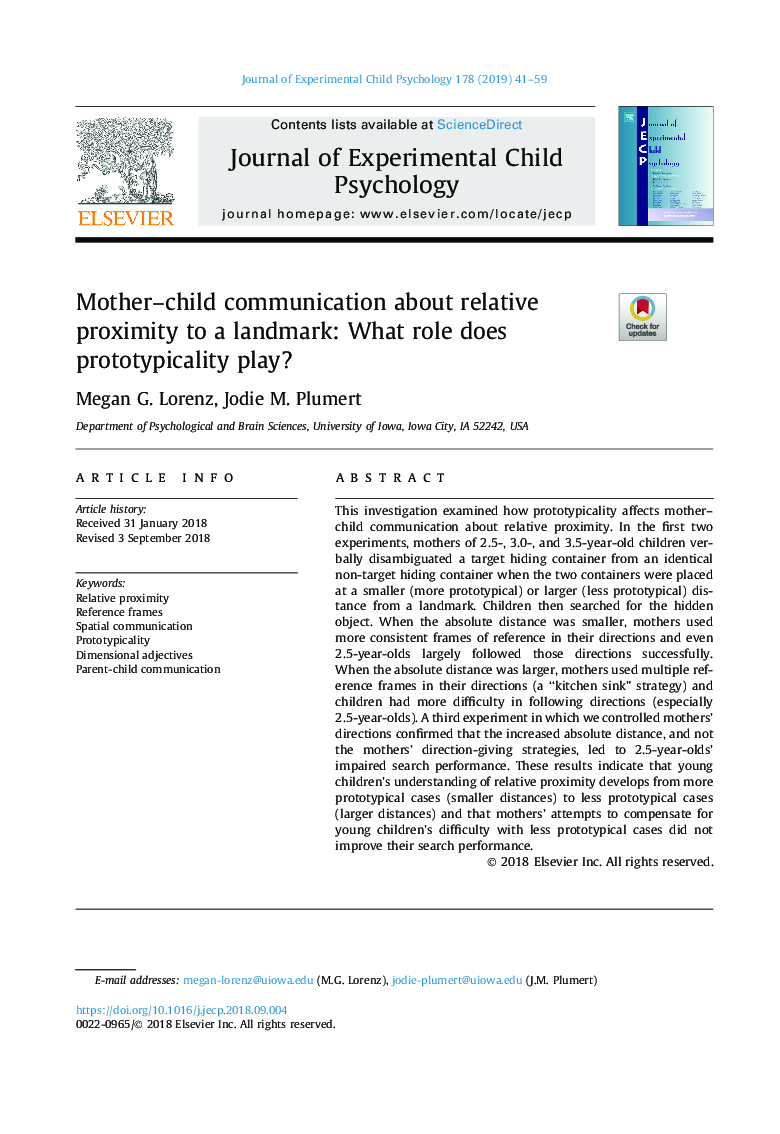| کد مقاله | کد نشریه | سال انتشار | مقاله انگلیسی | نسخه تمام متن |
|---|---|---|---|---|
| 11262797 | 1831921 | 2019 | 19 صفحه PDF | دانلود رایگان |
عنوان انگلیسی مقاله ISI
Mother-child communication about relative proximity to a landmark: What role does prototypicality play?
ترجمه فارسی عنوان
ارتباط مادر و کودک درباره نزدیکی نسبی به یک نقطه عطفی: نقش نخستین بازی چیست؟
دانلود مقاله + سفارش ترجمه
دانلود مقاله ISI انگلیسی
رایگان برای ایرانیان
کلمات کلیدی
نزدیکی نسبی، فریم های مرجع، ارتباط فضایی، نمونه اولیه، ویژگی های ابعاد، ارتباط پدر و مادر،
ترجمه چکیده
در این تحقیق بررسی شده است که چگونه پیش آمین بودن ارتباط ارتباط مادر و کودک را در مورد نزدیکی نسبی تاثیر می گذارد. در دو آزمایش اول، مادران کودکان 2.5، 3.0، و 3.5 ساله به طور صحیح مخزن مخفی هدف را از یک مخزن مخفی غیر هدف جدا کرد، زمانی که دو کانتینر کوچکتر (نمونه اولیه بیشتر) یا بزرگتر (کمتر از نمونه اولیه) فاصله از نقطه عطفی. سپس کودکان برای شیء پنهان جستجو کردند. هنگامی که فاصله مطلق کوچکتر بود، مادران از مسیرهای سازگارتر مرجع خود در جهت خود استفاده می کردند و حتی آنها 2.5 ساله به طور موفقیت آمیز به این جهات پی بردند. هنگامی که فاصله مطلق بزرگتر بود، مادران از جهت های مختلف چندین مرجع استفاده می کردند (یک استراتژی سینک آشپزخانه) و بچه ها در مسیرهای زیر (مخصوصا 2.5 ساله) مشکلاتی داشتند. آزمایش سوم که در آن مسیرهای مادران ما را کنترل کرد، تایید کرد که افزایش فاصله مطلق، و نه استراتژی های هدایت مادران، منجر به نقض عملکرد جستجوی 2.5 ساله شد. این نتایج نشان می دهد که درک جوانان از نزدیکی نسبی از پروتوکل های دیگر (فاصله های کوچکتر) تا پرونده های نمونه های کوچکتر (فاصله های بزرگتر) توسعه می یابد و تلاش های مادران برای جبران مشکل کودکان جوان با موارد نمونه اولیه کمتری بهبود عملکرد جستجو را بهبود نمی بخشد.
موضوعات مرتبط
علوم انسانی و اجتماعی
روانشناسی
روانشناسی رشد و آموزشی
چکیده انگلیسی
This investigation examined how prototypicality affects mother-child communication about relative proximity. In the first two experiments, mothers of 2.5-, 3.0-, and 3.5-year-old children verbally disambiguated a target hiding container from an identical non-target hiding container when the two containers were placed at a smaller (more prototypical) or larger (less prototypical) distance from a landmark. Children then searched for the hidden object. When the absolute distance was smaller, mothers used more consistent frames of reference in their directions and even 2.5-year-olds largely followed those directions successfully. When the absolute distance was larger, mothers used multiple reference frames in their directions (a “kitchen sink” strategy) and children had more difficulty in following directions (especially 2.5-year-olds). A third experiment in which we controlled mothers' directions confirmed that the increased absolute distance, and not the mothers' direction-giving strategies, led to 2.5-year-olds' impaired search performance. These results indicate that young children's understanding of relative proximity develops from more prototypical cases (smaller distances) to less prototypical cases (larger distances) and that mothers' attempts to compensate for young children's difficulty with less prototypical cases did not improve their search performance.
ناشر
Database: Elsevier - ScienceDirect (ساینس دایرکت)
Journal: Journal of Experimental Child Psychology - Volume 178, February 2019, Pages 41-59
Journal: Journal of Experimental Child Psychology - Volume 178, February 2019, Pages 41-59
نویسندگان
Megan G. Lorenz, Jodie M. Plumert,
